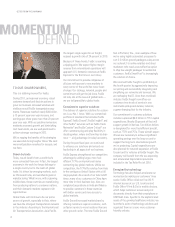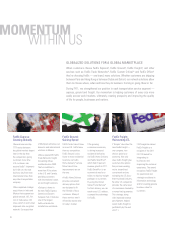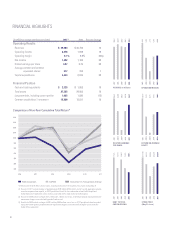Federal Express 2011 Annual Report Download - page 9
Download and view the complete annual report
Please find page 9 of the 2011 Federal Express annual report below. You can navigate through the pages in the report by either clicking on the pages listed below, or by using the keyword search tool below to find specific information within the annual report.
MORE
>
fedex.com/annualreport2011 7
Our hybrid-electric and
all-electric vehicles in
service worldwide. By
the end of FY11, we
increased the fleet by
nearly 20 percent.
The fleet has logged
9.5 million miles of
service — that’s almost
20 trips to the moon and
back. We’ll add close to
4,000 new, fuel-efficient
Sprinters this year.
Each vehicle is at least
100 percent more fuel
efficient than the most
common vehicle
it replaces.
WE’RE CREATING A MORE SECURE ENERGY FUTURE
The business of global trade can be complex, but we’ve kept our goal simple: to connect
the world in responsible and resourceful ways. We believe that our success and the future
of our environment are deeply intertwined.
Following are highlights of how we’re systematically increasing the efficiency of our
aircraft, vehicles and facilities. For a more comprehensive analysis, go to
and view our latest Global Citizenship Update. The report includes more information about
the four areas of our corporate citizenship: people and workplace, economics and access,
environment and efficiency, and community and disaster relief.
67%
75%
408
47%
5
Our progress toward
the goal we set in 2005
to reduce aircraft CO2
emissions intensity
20 percent by 2020.
Adding more 777Fs to
our fleet dramatically
enhances our ability
to move more freight
worldwide while
reducing aircraft
emissions per shipment.
The reduction in fuel
consumption per pound
of payload by replacing
727 aircraft with 757s.
The 777F, which can
fly directly from Asia
to our Memphis hub
without refueling,
allows later cutoff
times for customers
and represents an 18
percent increase in fuel
efficiency compared
with the MD11.
Our progress toward
the goal we set in 2005
to increase vehicle fuel
efficiency 20 percent by
2020. We’ve made
excellent progress each
year and are closing
in on our goal. Early
results for our all-electric
vehicles indicate that
operational and
maintenance costs could
be 70 to 80 percent
lower than those costs
for internal combustion
engines.
The number of facilities
that generate solar
energy onsite worldwide.
These facilities increase
our energy efficiency and
reduce CO2 emissions
by an estimated 3,918
metric tons per year.
We’ve also installed a
Bloom Energy ServerSM
in our Oakland Facility,
complementing our
existing solar array
there. The solid oxide
fuel cell technology
provides a cleaner, more
reliable and affordable
alternative to the
electric grid.
The number of FedEx
facilities that are ISO
14001-certified. This
international standard
specifies a process
for controlling and
improving an organiza-
tion’s environmental
performance. This year
we received Leadership
in Energy and Environ-
mental Design (LEED)
certification for our
first environmentally
sustainable data center
in Colorado Springs
and our FedEx World
Headquarters in Memphis.
51
AIRCRAFT EMISSIONS
AIRCRAFT FUEL EFFICIENCY
VEHICLE FLEET
VEHICLE FUEL EFFICIENCY
ALTERNATIVE ONSITE ENERGY
FACILITY CERTIFICATION






















